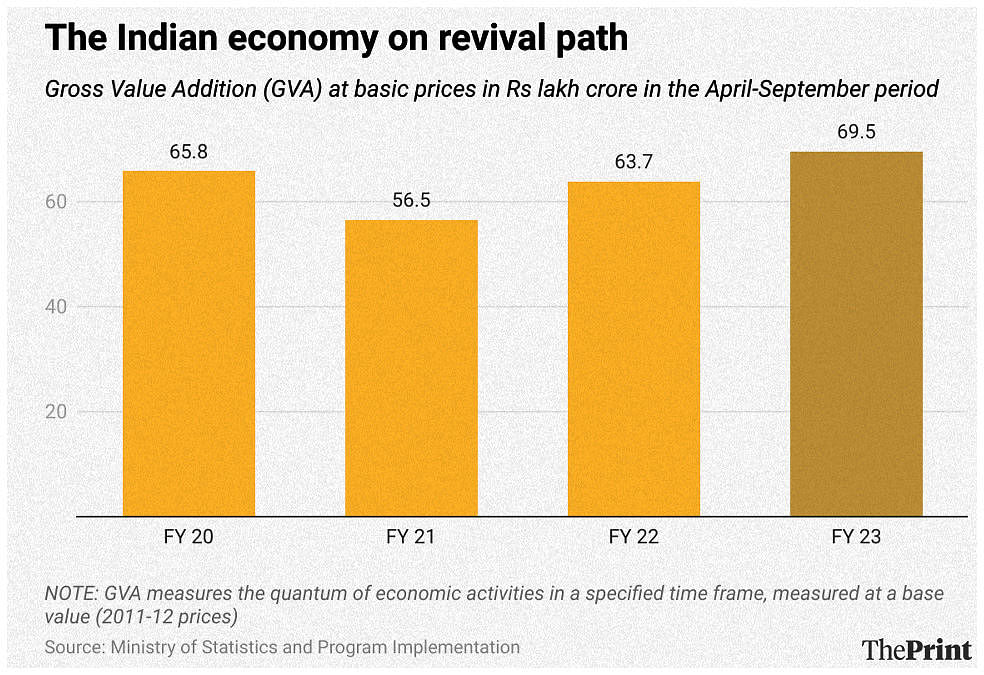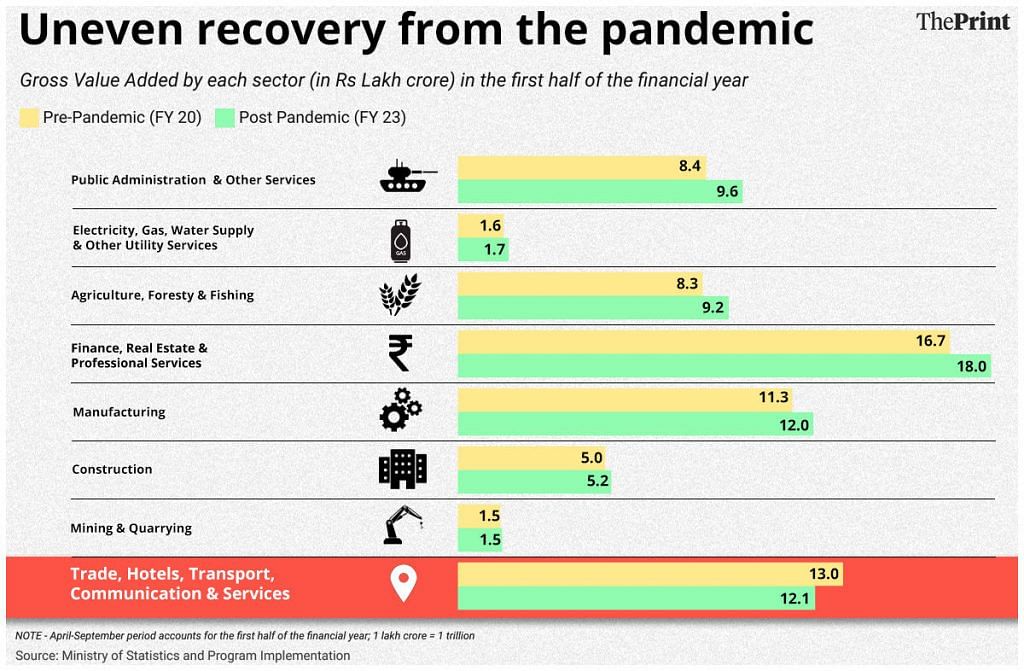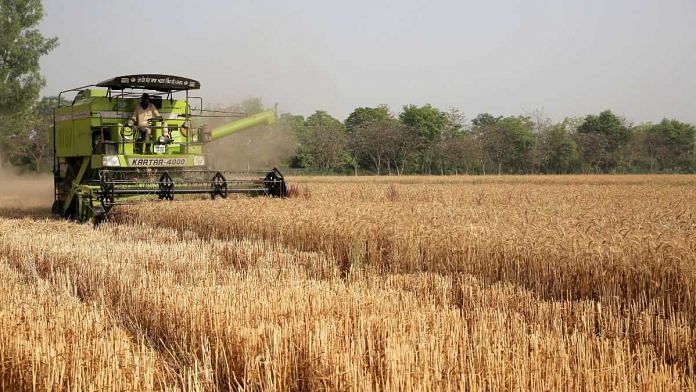New Delhi: After two years of disruptions due to Covid and other headwinds, India’s economy has been on the path of recovery this financial year, government data shows — but only some sectors have exceeded their pre-pandemic performance levels, with agriculture doing particularly well.
Overall, India’s Gross Domestic Product (GDP), or the monetary value of goods and services produced, was 5.6 per cent higher in the first half of 2022 (April-September) than in the comparable pre-pandemic period in 2019, shows National Accounts Statistics (NAS) data from the Ministry of Statistics and Programme Implementation (MoSPI).
However, a closer analysis of the data for gross value addition (the amount of economic activity) shows that not all sectors of the economy have grown at the same pace.

While agriculture and a couple of other sectors have registered double-digit growth over their pre-pandemic level, others like hospitality and broadcasting have lagged behind the national average.
Here is a look at how different sectors have performed until September when compared to their pre-pandemic levels.

Trade, tourism, transport, and broadcasting
As its name suggests, the ‘Trade, Hotels, Transport, Communication & Services related to Broadcasting’ sector encompasses numerous industries. While it has been on the path to recovery, it is not yet back to pre-pandemic levels.
At Rs 12.1 lakh crore, the gross value addition, or GVA, in this sector for the first half of 2022-23 was about 7.2 per cent lower than Rs 13 lakh crore in the first half of FY 2019-20.
In the first half of 2021-22, this sector was 22 per cent below pre-pandemic levels.
In other words, although the shortfall in activity as compared to pre-pandemic levels has been declining, this multi-industry sector earned less in this year’s first half than it did in April-September 2019.
Also Read: Why Modi govt’s rejig of food subsidy bill is as much good politics as it is sound economics
Mining, quarrying, and construction
Recovery in this sector has been slow but steady. In the April-September period of 2022-23, the economic output generated by mining and quarrying was Rs 1.52 lakh crore, about 2.9 per cent higher than the pre-pandemic value of Rs 1.47 lakh crore.
Construction activities performed somewhat better during this period at Rs 5.2 lakh crore coming, which is 4.1 per cent higher than pre-pandemic levels.
Manufacturing
The pandemic saw the manufacturing sector contract by 0.6 per cent in 2020-21. The sector subsequently saw a significant recovery in 2021-22, with growth coming in at 11.5 per cent.
However, this year, the sector hasn’t grown with the same vigour. In the first half of 2022-23, the output by manufacturing — Rs 12.03 lakh crore — was just 6.3 per cent above the corresponding pre-pandemic period.
In a pre-budget presentation made on 20 December, economists from the National Institute of Public Finance and Policy (NIPFP), an autonomous research institute under the ministry of finance, said that their research showed how the health of the manufacturing sector is linked to the automobiles sector. They explained that during the pandemic, public transportation came to a standstill and people started opting for private vehicles, which led to the auto industry cushioning the manufacturing sector.
However, as normalcy is returning and car sales are cooling down, it is growth in non-auto sectors — specifically consumer non-durables produced by micro, small and medium enterprises (MSMEs) — that will drive growth.
According to Rudrani Bhattacharya, associate professor at NIPFP, “Consumer non-durables sector mainly belonging to MSMEs can emerge as a driver of growth as private consumption demand is showing signs of revival, provided this sector is given production linked incentives. Only credit link incentive is not sufficient to boost this sector.”
Finance, real estate, and professional services
Finance, real estate and professional services form a little over 20 per cent of the total value addition in the economy. However, despite being significantly impacted by Covid, this sector grew by 2.2 per cent during 2020-21 and by 4.2 per cent during the year that followed.
A major chunk of contact-less services, which can be delivered via work from home, come under this segment, which is why these services remained resilient during the pandemic.
In the current fiscal, despite a relatively higher base, the sector is growing quickly. The economic output in the first half of 2022-23 of this sector was 8.4 per cent above pre-pandemic levels.
Electricity, gas, water supply, and other utility services
This sector has revived quite comfortably. In the first half of this financial year, it recorded economic activities worth Rs 1.74 lakh crore, 11 per cent higher than the pre-pandemic level of Rs 1.6 lakh crore in 2019-20.
Agriculture
During the pandemic, when output from all other economic activities contracted, the agriculture sector was the lone bright spot, growing 3 per cent in 2020-21 while other sectors were either contracting or witnessing anaemic growth.
This year, too, agricultural output is strong. In the first half of 2022-23, the output by Agriculture, Forestry and Fishing was 10.8 per cent above pre-pandemic levels, making it one of the only sectors comfortably above pre-pandemic levels.
NIPFP’s Bhattacharya said that growth in the agricultural sector could be attributed to various reasons, including the government’s credit stimulus package, which encouraged agricultural loans.
The mass migration of unskilled labour also worked in favour of agriculture as “more hands were available” for sowing and harvesting, she said. Favourable rainfall and an increase in the Minimum Support Prices (MSP) provided a further boost to the sector, she added.
Public administration, defence, and other services
This sector, where the expenditure is mostly made by the government, witnessed a steep growth this year.
In the first half of 2022-23, the government spent about Rs 9.6 lakh crore which is 14.4 per cent higher than the pre-pandemic level of Rs 8.4 lakh crore. This growth coincides with the government’s thrust on infrastructure spending.
(Edited by Asavari Singh)
Also Read: ‘Remarkably resilient, better prepared’: World Bank revises India’s economic growth to 6.9% for FY23



